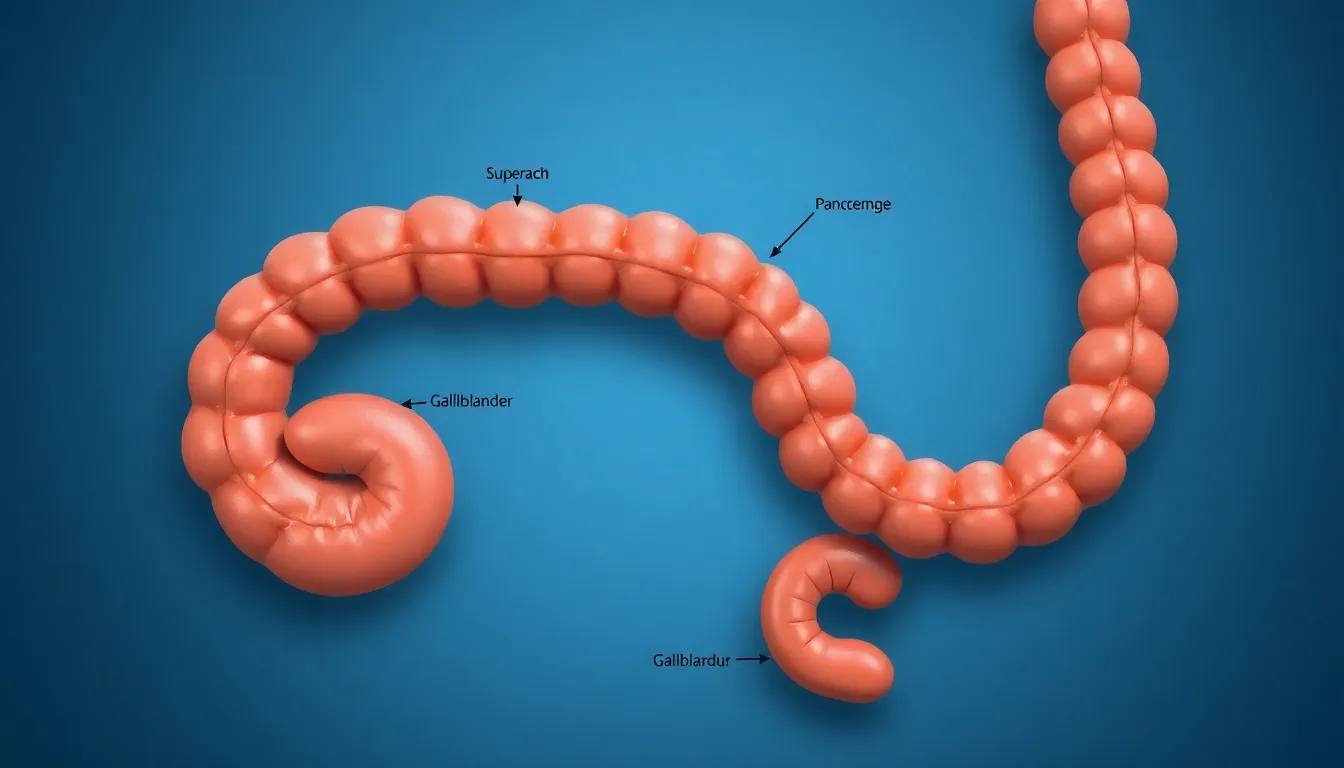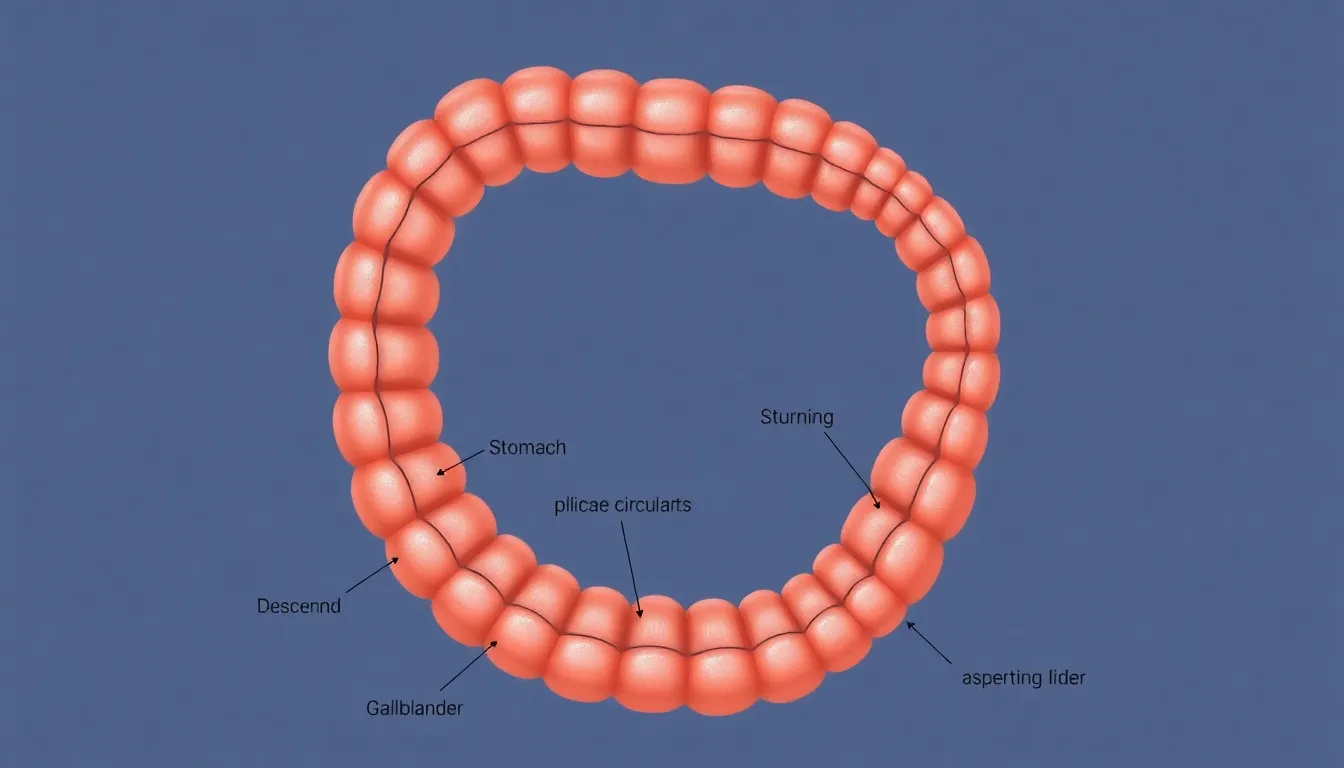Table of Contents
ToggleThe duodenum, the first section of the small intestine, plays a crucial role in digestion. Located just after the stomach, it acts as a vital connector, where partially digested food meets bile and pancreatic juices. This interaction is essential for breaking down nutrients, allowing the body to absorb them efficiently.
Understanding the duodenum’s functions can shed light on the overall digestive process. It not only aids in the digestion of proteins, fats, and carbohydrates but also regulates the flow of digestive enzymes. By exploring what the duodenum does, one can appreciate its importance in maintaining digestive health and overall well-being.
What Does the Duodenum Do?
The duodenum plays a crucial role in digestion and nutrient absorption. It acts as the primary site for mixing chyme, bile, and pancreatic enzymes. This mixture enhances the breakdown of food into smaller, absorbable molecules.
Nutrient Breakdown
- Proteins: The duodenum activates enzymes like trypsin and chymotrypsin, which break proteins into peptides and amino acids.
- Fats: Bile acids emulsify fats, allowing pancreatic lipase to further digest them into fatty acids and glycerol.
- Carbohydrates: Pancreatic amylase converts starches into simpler sugars, facilitating absorption.
Enzyme Regulation
The duodenum regulates the release of digestive enzymes and hormones, such as secretin and cholecystokinin (CCK). Secretin triggers bicarbonate release from the pancreas, neutralizing stomach acid. CCK stimulates the release of bile from the gallbladder, promoting fat digestion.
Nutrient Absorption
The duodenum absorbs vital nutrients such as vitamins, minerals, and amino acids through its lining. Its large surface area, enhanced by villi and microvilli, maximizes absorption efficiency.
Protective Function
The duodenum also guards against pathogens. It secretes antimicrobial substances to protect the body from harmful bacteria and pathogens entering through food.
The duodenum significantly contributes to digestion and nutrient absorption. Its functions support overall digestive health and facilitate the essential processes required for nutrient uptake.
Anatomy of the Duodenum

The duodenum is the first part of the small intestine and is approximately 25 centimeters (10 inches) long. Its anatomy is crucial for its digestive functions, as it interacts with various organs to facilitate nutrient breakdown and absorption.
Location and Structure
The duodenum lies between the stomach and the jejunum, with a C-shaped structure that wraps around the pancreas. It consists of four segments:
- Superior part: Located just after the pylorus of the stomach, it receives chyme from the stomach.
- Descending part: This section descends vertically and houses landmarks like the major duodenal papilla, where bile and pancreatic juices enter.
- Horizontal part: Positioned horizontally across the spine, it is closely associated with the pancreas.
- Ascending part: This segment transitions into the jejunum and is anatomically connected through the duodenojejunal flexure.
The walls of the duodenum contain circular folds, known as plicae circulares, which increase surface area for nutrient absorption.
Relationship with Other Organs
The duodenum has vital relationships with several organs:
- Stomach: The duodenum receives chyme from the stomach, marking the beginning of nutrient digestion.
- Pancreas: It connects with the pancreas via the pancreatic duct, allowing enzymes like trypsin and amylase to enter for digestion.
- Liver and Gallbladder: Bile from the liver and gallbladder enters through the common bile duct, aiding in fat emulsification.
- Jejunum: Nutrient absorption continues into the jejunum, maintaining a seamless digestive process.
These relationships ensure that the duodenum effectively processes food, making it essential for proper digestion and nutrient utilization.
Functions of the Duodenum
The duodenum performs several crucial functions that contribute to digestion, nutrient absorption, and hormonal regulation. Its role is integral to breaking down food substances and ensuring optimal nutrient utilization.
Digestion Process
The duodenum initiates the digestion process by receiving chyme from the stomach. In this section, enzymes and digestive juices mix with chyme to facilitate nutrient breakdown. Bile acids from the liver emulsify fats, increasing their surface area for enzyme action. Pancreatic juices provide essential enzymes, including trypsin and chymotrypsin, which further digest proteins. Pancreatic amylase converts starches into simpler sugars, ensuring carbohydrates are efficiently processed. This coordinated action results in the effective breakdown of macronutrients, preparing them for absorption.
Nutrient Absorption
The duodenum’s primary role involves nutrient absorption, utilizing its extensive surface area enhanced by villi and microvilli. This structure maximizes contact with digested food materials. Vitamins, minerals, and amino acids enter the bloodstream through the intestinal lining. Monosaccharides, such as glucose and fructose, also absorb here, providing immediate energy sources. The duodenum’s efficient absorption methods directly impact overall health by delivering vital nutrients that the body requires.
Hormonal Functions
The duodenum regulates digestive processes by secreting hormones, primarily secretin and cholecystokinin (CCK). Secretin stimulates the pancreas to release bicarbonate, neutralizing stomach acid and creating an optimal environment for enzyme function. CCK promotes bile release from the gallbladder and enhances pancreatic enzyme secretion, supporting fat and protein digestion. These hormones respond to food presence in the duodenum, ensuring a coordinated digestive response that optimizes nutrient breakdown and absorption.
Common Disorders of the Duodenum
Common disorders of the duodenum can impact digestion and overall health. Understanding the symptoms, diagnosis, and treatment options is essential for effective management.
Symptoms and Diagnosis
Symptoms of duodenal disorders may include abdominal pain, nausea, vomiting, bloating, and changes in stool consistency. Patients might experience weight loss or poor appetite due to malabsorption issues. Diagnostic procedures include upper gastrointestinal endoscopy, which allows direct visualization of the duodenum, and imaging studies like CT scans or ultrasounds to assess structural abnormalities. Laboratory tests can evaluate nutrient levels and detect infections, inflammation, or other underlying conditions affecting the duodenum.
Treatment Options
Treatment options for duodenal disorders vary based on the specific condition.
- Medications: Proton pump inhibitors may reduce acid production, while antibiotics treat infections.
- Dietary Changes: A low-fat diet can benefit those with malabsorption issues.
- Surgery: Surgical procedures might be necessary for tumors, blockages, or other structural problems.
- Nutritional Support: In severe cases, patients may require nutritional supplements or enteral feeding to ensure adequate nutrient intake.
Each approach aims to alleviate symptoms and restore normal digestive function.
The duodenum serves as a vital hub in the digestive process. Its unique structure and functions are essential for breaking down food and absorbing nutrients effectively. By regulating the release of enzymes and hormones it ensures that digestion occurs smoothly and efficiently. Understanding the role of the duodenum not only highlights its importance in digestion but also emphasizes the need for maintaining its health. Awareness of potential disorders can lead to timely diagnosis and treatment. This knowledge empowers individuals to take charge of their digestive health and overall well-being.







